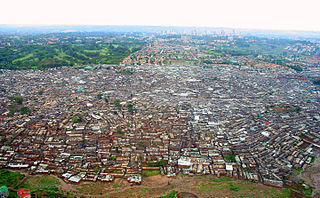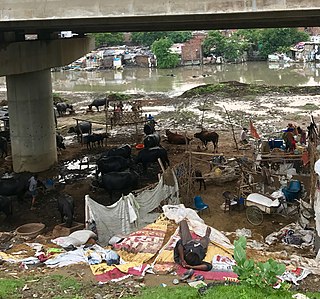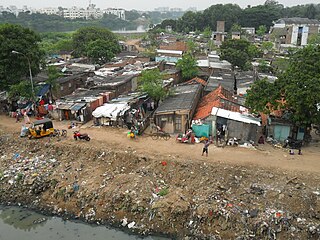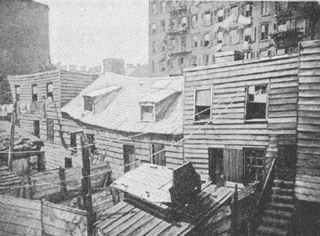
A slum is a highly populated urban residential area consisting of densely packed housing units of weak build quality and often associated with poverty. The infrastructure in slums is often deteriorated or incomplete, and they are primarily inhabited by impoverished people. Although slums are usually located in urban areas, in some countries they can be located in suburban areas where housing quality is low and living conditions are poor. While slums differ in size and other characteristics, most lack reliable sanitation services, supply of clean water, reliable electricity, law enforcement, and other basic services. Slum residences vary from shanty houses to professionally built dwellings which, because of poor-quality construction or lack of basic maintenance, have deteriorated.

Dharavi is a suburb in Mumbai, Maharashtra, India. With a population of around 1 million, it is considered to be the world's third largest slum after Pakistan's Orangi, Karachi and Mexico's Ciudad Neza, Mexico City. Dharavi has an area of just over 2.39 square kilometres and a population of about 1,000,000. With a population density of over 277,136/km2 (717,780/sq mi), Dharavi is one of the most densely populated areas in the world.

A shanty town or squatter area is a settlement of improvised buildings known as shanties or shacks, typically made of materials such as mud and wood. A typical shanty town is squatted and in the beginning lacks adequate infrastructure, including proper sanitation, safe water supply, electricity and street drainage. Over time, shanty towns can develop their infrastructure and even change into middle class neighbourhoods. They can be small informal settlements or they can house millions of people.

Kibera is a division of Nairobi Area, Kenya, and neighbourhood of the city of Nairobi, 6.6 kilometres (4.1 mi) from the city centre. Kibera is the largest slum in Nairobi, and the largest urban slum in Africa. The 2009 Kenya Population and Housing Census reports Kibera's population as 170,070, contrary to previous estimates of one or two million people. Other sources suggest the total Kibera population may be 500,000 to well over 1,000,000 depending on which slums are included in defining Kibera.
Jockin Arputham was an Indian community leader and activist, known for his campaigning work of more than 40 years on issues related to slums and shanty towns. He was born in Karnataka, India and moved to Mumbai, where he quickly became politicized and established himself as a community leader. In 2014, he was nominated for the Nobel Peace Prize, alongside the organisation he helped to found, Slum Dwellers International.
The National Slum Dwellers Federation (NSDF) in India was established by Jockin Arputham when he fought on behalf of a community of 70,000 to appeal a 1976 eviction order. It is a national organization which brings together multiple communities and their leaders who live in slum settlements around India. NSDF along with Mahila Milan are one of the oldest members of the Urban Poor Fund International Network. Due to the efforts of NSDF, around 90 buildings and 300 toilet blocks have been constructed in Mumbai, providing houses and sanitation to over 35,000 families. Additionally, around 100 toilet blocks have been constructed in Pune.
Mahila Milan is a self-organised, decentralised collective of female pavement dwellers in Bombay. The group works with issues such as housing, sanitation, and grassroots lending schemes. It aims at gaining women equal recognition for improvement of their communities, while indulging in important decision making activities. The loans granted by the group to its members in times of need, are sanctioned in the name of the woman of the house.
The Slum Rehabilitation Act 1995 was passed by the government of the Indian state Maharashtra to protect the rights of swamp dwellers and promote the development of swamp areas. The Act protected from eviction, anyone who could produce a document proving they lived in the city of Mumbai before January 1995, regardless if they lived on the swamp or other kinds of marsh land. The ACT was the result of policy development that included grassroots slum dweller organisations, particularly SPARC.
We, the Invisible was a report based on a 1985 census of around 6,000 pavement dweller families, funded and carried out by the Society for the Promotion of Area Resource Centers (SPARC) and the Society for Participatory Research in India (PRIA). It drew attention to this disadvantaged group and helped to reduce the number of violent evictions.
Yamuna Pushta is the Pushta (embankment) on both sides of the Yamuna River in Delhi, starting from the ITO bridge and up to the Salimgarh Fort. It has also been home to riverbed cultivators, and over 100,000 residents a string of slum colonies (shantytown) for some 40 years, mostly on the western banks, like those near the Nigambodh Ghat near Old Delhi and a few on the eastern banks like those near Sakarpur village in East Delhi. Many of these slums were being demolished in 2004, after court orders which were part of the beautification drive of the Government ahead of the 2010 Commonwealth Games and for creating a "green belt".

Tamil Nadu Urban Habitat Development Board (TNUDB), formerly known as Tamil Nadu Slum Clearance Board, is administrated by Government of Tamil Nadu to remove slums in the state. It was formed by Tamil Nadu Slum Areas (Improvement & Clearance) Act 1971. The main function of the board is to eradicate slums and provide hygienic tenements in Tamil Nadu.

Homelessness is a major issue in India. The Universal Declaration of Human Rights defines 'homeless' as those who do not live in a regular residence. The United Nations Economic and Social Council Statement has a broader definition for homelessness; it defines homelessness as follows: ‘When we are talking about housing, we are not just talking about four walls and a roof. The right to adequate housing is about security of tenure, affordability, access to services and cultural adequacy. It is about protection from forced eviction and displacement, fighting homelessness, poverty and exclusion. India defines 'homeless' as those who do not live in Census houses, but rather stay on pavements, roadsides, railway platforms, staircases, temples, streets, in pipes, or other open spaces. There are 1.77 million homeless people in India, or 0.15% of the country's total population, according to the 2011 census consisting of single men, women, mothers, the elderly, and the disabled. However, it is argued that the numbers are far greater than accounted by the point in time method. For example, while the Census of 2011 counted 46.724 homeless individuals in Delhi, the Indo-Global Social Service Society counted them to be 88,410, and another organization called the Delhi Development Authority counted them to be 150,000. Furthermore, there is a high proportion of mentally ill and street children in the homeless population. There are 18 million street children in India, the largest number of any country in the world, with 11 million being urban. Finally, more than three million men and women are homeless in India's capital city of New Delhi; the same population in Canada would make up approximately 30 electoral districts. A family of four members has an average of five homeless generations in India.

Illegal housing in India consists of huts or shanties built on land not owned by the residents and illegal buildings constructed on land not owned by the builders or developers. Although illegal buildings may afford some basic services, such as electricity, in general, illegal housing does not provide services that afford for healthy, safe environments.

Rooftop slum or penthouse slum generally refers to illegal housing on the rooftops of apartment buildings. In Hong Kong, some people are unable to afford traditional apartments and are forced to wait years for affordable public housing. They therefore live in squatted shacks on top of buildings. According to the Hong Kong population census, there were 47,091 rooftop dwellers in 2011 and this number is likely to have dropped as working class areas are redeveloped.

Chennai is the capital city of the South Indian state of Tamil Nadu and is the fourth largest metropolitan city in the country. A total of 30% of Chennai's population resided in slums as of 2011. The state government of Tamil Nadu has established a Slum clearance Board, with a minister heading it. Out of the major cities with the highest population in slums, Chennai ranks fourth after Mumbai, Hyderabad and Kolkota. Rapid urbanization and employment in the unorganized sector is the major factor for the slum population in Chennai.
Ghar Bachao Ghar Banao Aandolan is a people's movement that emerged in the backdrop of massive slum demolitions in Mumbai in 2003–04. It started in 2005 as a struggle for housing rights in Mumbai, and continues to fight for rights of slum-dwellers and those cheated by the builders in various rehabilitation and redevelopment projects, including slum-dwellers, those affected by the Slum Rehabilitation Act and the unorganised sector workers. It is a part of the National Alliance of People's Movements and is led by Medha Patkar.
JJ Colony is a resettlement colony on the Gram Sabha Land of Madanpur Khadar Village in the south-eastern region of Delhi. It is located in close proximity to Sarita Vihar and Kalindi Kunj, about 1 kilometers from the Uttar Pradesh border. It was created in 2004 when the slum dwellers from across Delhi were forcefully evicted and relocated to the urban peripheries. Since its formation, the community has undergone massive structural, political, economic, and social changes affecting the lives of the community. The transformation of JJ Colony in Khadar is underscored by several challenges ranging from the provision of basic amenities, mobility, and the condition of women's safety. From then to now JJ colony in khadar has changed much from the lanes of agriculture canal to road channels has come far bit.

Slum clearance in the United Kingdom has been used as an urban renewal strategy to transform low-income settlements with poor reputation into another type of development or housing. Early mass clearances took place in the country's northern cities. Starting from 1930, councils were expected to prepare plans to clear slum dwellings, although progress stalled upon the onset of World War II.

Slum clearance in the United States has been used as an urban renewal strategy to regenerate derelict or run-down districts, often to be replaced with alternative developments or new housing. Early calls were made during the 19th century, although mass slum clearance did not occur until after World War II with the introduction of the Housing Act of 1949 which offered federal subsidies towards redevelopments. The scheme ended in 1974 having driven over 2,000 projects with costs in excess of $50 billion.

Squatting in Ghana is the occupation of unused land or derelict buildings without the permission of the owner. Informal settlements are found in cities such as Kumasi and the capital Accra. Ashaiman, now a town of 100,000 people, was swelled by squatters. In central Accra, next to Agbogbloshie, the Old Fadama settlement houses an estimated 80,000 people and is subject to a controversial discussion about eviction. The residents have been supported by Amnesty International, the Centre on Housing Rights and Evictions and Shack Dwellers International.












